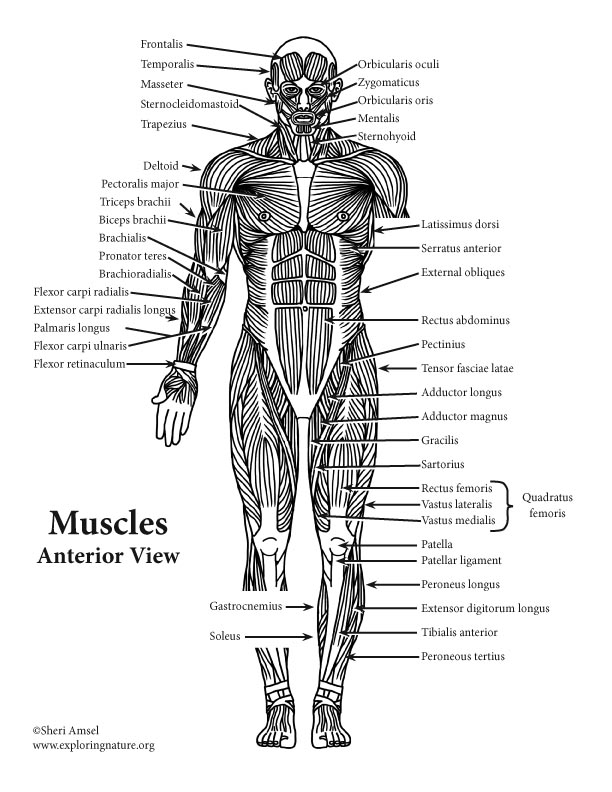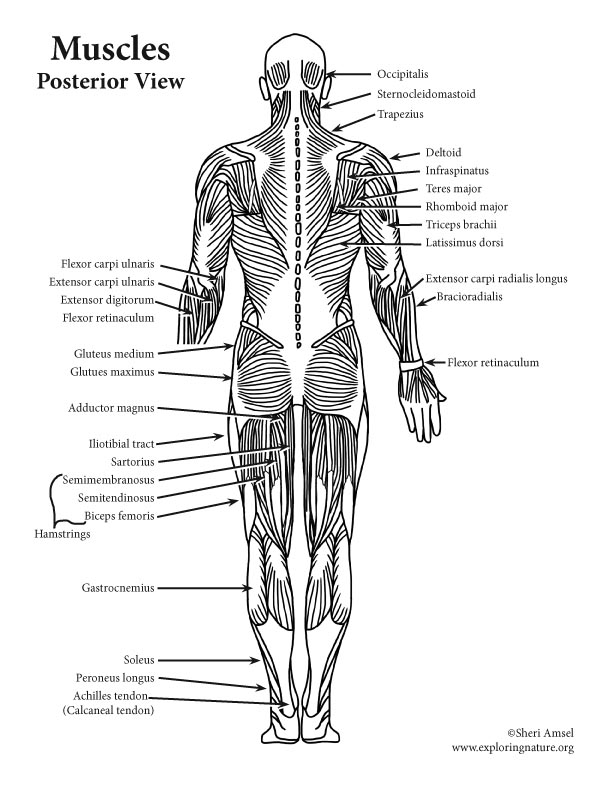

There are over 600 muscles in the human body. Muscles are named for their:
Muscle tissue is made up of fibers that allow them to contract (squeeze down smaller) and relax (stretch out long again). Our muscles contracting and relaxing is how we move, but this is just one of our muscles’ four main jobs. They also stabilize our joints, so that when we move, our knees, hips, shoulders, and many other joints are protected and strong. They keep us warm – every contraction generating a small amount of heat. They help us hold our position while sitting – our posture. To do this, our muscles are working against gravity all day long, though we don’t usually notice it. We also use muscles to smile, roll our eyes, chew, laugh, breathe and even speak. Even if our jobs are not physically challenging, by the end of very day, our muscles are tired and getting into bed and relaxing our muscles feels good.
The four jobs of muscles:
When a muscle contracts, all the tiny fibers slide by each other forming a shorter but much thicker muscle, like sliding two piles of playing cards together. When a body builder flexes their muscles by bending an arm at the elbow, the biceps muscle contracts, looking thicker (and impressive). What you are seeing is all the muscle fibers sliding together, to make a shorter, more compact muscle. The muscle will actually feel harder and thicker to the touch when flexed.
There are three kinds of muscles in the body: skeletal muscle, cardiac muscle, and smooth muscle.
1) Skeletal muscle makes up almost half of the bulk of your body. If you squeeze your thigh, calf, or arm, you are squeezing skeletal muscle. These are the muscles that move your arms and legs as you swim, run or climb. Skeletal muscle is packaged into the muscles of our limbs that cover our boney skeleton. They are striated, multinucleate, and are controlled by us – they are voluntary. When you want to move, a signal goes from your brain to the skeletal muscles of your legs or arms. The muscles contract quickly and powerfully. This pulls on the bone to which they are attached and it makes you move.
Because skeletal muscles use a lot of force, they are protected and made stronger by tough connective tissue coverings. These are attached to tendons that attach the muscles to the bones. One muscle may have a few tendons that attach it to several bones at a time. An example of that are the forearm muscles that flex and extend the fingers. One muscle, called extensor digitorum, is attached to your pointer, middle and ring finger. When it contracts, it works with other muscles to open your hand.
Skeletal muscles work in pairs. For example, you have a group of muscles that flex your joints and a group of muscles that extend your joints. These two muscle groups work together to allow smooth and accurate movements of your body.
Skeletal Muscle Health
Skeletal muscle has to be used regularly to stay healthy. You can lose as much as 5% of your muscle fitness every day that you lie in bed not moving. It would take just a few weeks of lying on the couch to lose much of your fitness. An injury or illness that requires bed rest, can have a profound effect on muscle fitness. This is called disuse atrophy.
Aerobic exercise, on the other hand, such as swimming, running, or biking, increases muscle endurance and strength. It also increases the efficiency of metabolism, improves skeletal and general health.
Skeletal muscle contractions need calcium and energy. When an athlete exercises for an extended period, they sweat and burn calories and use up their minerals. Energy drinks, like Gatorade, replace the minerals and calories they need so they can continue to exercise. Exhaustion and muscle cramps can result from using up the body’s reserve of calories and calcium needed for muscle contraction.
2) Cardiac muscle is found only in the heart. It is striated, but is not under our control. Cardiac muscles are involuntary. They are told what to do by signals from the brain and body that are sent out without us even knowing it. Cardiac muscle is like skeletal muscle – when it contracts, it contracts fast and hard and then relaxes. But cardiac muscle, like smooth muscle, works without us knowing. It has to keep our blood pumping night and day, even while we are asleep. All the muscle in the heart is linked so that it will contract in a wave to keep the blood moving through it. With every heart beat, a muscle contraction sends blood on its way to feed the body what it needs.
3) Smooth muscle is spread out all over the body, found in the walls of all our visceral organs (stomach, intestines, bladder, etc.), respiratory system, blood vessels and even our skin (not in heart). Smooth muscle traits includes:
Muscle Properties
To do their jobs for the body, muscles have special functional properties:
When you research information you must cite the reference. Citing for websites is different from citing from books, magazines and periodicals. The style of citing shown here is from the MLA Style Citations (Modern Language Association).
When citing a WEBSITE the general format is as follows.
Author Last Name, First Name(s). "Title: Subtitle of Part of Web Page, if appropriate." Title: Subtitle: Section of Page if appropriate. Sponsoring/Publishing Agency, If Given. Additional significant descriptive information. Date of Electronic Publication or other Date, such as Last Updated. Day Month Year of access < URL >.
Amsel, Sheri. "About Muscles" Exploring Nature Educational Resource ©2005-2024. December 13, 2024
< http://www.exploringnature.org/db/view/About-the-Muscular-System >


